Modeling Sediment Bypassing around Idealized Rocky Headlands
Abstract
:- A numerical model sediment transport study identified controlling factors and mechanisms for the potential of sediment to bypass a headland.
- A generalized analytical framework of flow disruption and sediment volume refined the factors and conditions useful to address sediment bypassing.
- The controlling factors on sediment bypassing a headland are wave angle, size, and shape of the headland, and sediment grain size.
1. Introduction
2. Background
2.1. Modeling Flow and Flux around Headlands
2.2. Headlands as Barriers to Sediment Flux
2.3. Factors That Affect Sediment Bypassing a Headland
- Morphology (oceanography and sediment factors held constant to compare headland shape and size):
- How does headland morphology affect alongshore flow?
- How does headland morphology affect sediment deposition amounts and patterns?
- Oceanography (morphology and sediment factors held constant to compare different oceanographic conditions):
- How do ocean conditions (i.e., tides, wave height, wave period, wave direction, and regional current) influence sediment flux around headlands?
- Sedimentology (morphology and oceanography factors held constant to compare sediment dynamics):
- How do differently sized sand fractions respond to identical morphological and oceanographic conditions?
- How does bed sediment availability at a headland influence sediment flux around that headland?
- Overall Bypassing (integrating all factors):
- What characteristics of morphology and oceanography lead to bypassing at a headland for which grain sizes?
3. Materials and Methods
3.1. Headland Morphology
3.2. Numerical Models
3.3. Model Input
3.3.1. Model Grids and Bathymetry
3.3.2. Oceanographic Forcing Terms
3.3.3. Sediment
3.4. Modeling Approach
3.4.1. Uncertainty in Modeling
3.5. Analysis Approach
3.5.1. Morphology
3.5.2. Oceanography
3.5.3. Sedimentology
3.5.4. Overall Bypassing
- Bed Eroded—sediment flux is larger across the downdrift shoulder, indicating bed erosion in front of the headland is supplying sediment.
- Unconstrained—sediment flux is steady and uninterrupted by the headland.
- Constrained—sediment flux is reduced between the updrift and downdrift shoulders by the headland.
- Blocked—sediment flux from the updrift to downdrift shoulder is prevented by the headland.
- Opposed Pathways—bypassing does not occur due to divergent (convergent) flow at the shoulders that direct sediment away (toward) the headland apex.
3.5.5. Forcing Terms
4. Results
4.1. General Current and Deposition Patterns
4.2. Analyses of Key Factors
4.2.1. Morphology
4.2.2. Oceanography
4.2.3. Sediment
4.2.4. Overall Bypassing
4.3. Forcing Terms and Sediment Response
4.3.1. Observations of Hydrodynamics
4.3.2. Observations of Stresses and Sediment Transport
5. Discussion
5.1. Factors Affecting Sediment Bypassing
- Morphology—The set of Mfactors that tested size and shape showed that size is a more important parameter than shape based on the larger headlands of T7 and T8 causing more widespread disruption to flow and deposition of sediment. However, within the two size groups (i.e., large and small), the blockier headlands of T6 and T8 cause more disruption than their pointed companions.
- Oceanography—The set of Ofactors that tested wave angle and wave power identified that large waves at an oblique angle generated 1–2 magnitudes more Qs than small Hs at an oblique angle or large Hs at a direct angle. The addition of a relatively slow (U < 0.1 m/s) regional current did not markedly enhance Qs. Although highly oblique short-period waves can cause high Qs [60,61], the analysis indicated that energy conditions must be coupled with the wave angle to offer a more complete understanding of bypassing potential. The high-energy oblique conditions were selected for more in-depth analysis because they produced a more dynamic response in the models that was independent of the headland morphology.
- Sedimentology—The relationships testing sediment D50 show that finer sands move more than coarser sands, as expected. However, the sediment availability based on the substrate type (sandy bed vs. reefed headland) showed that distinguishing between alongshore littoral transport and localized resuspension processes is important.
Specifying Sediment Bypassing Potential
5.2. Mechanisms for Sediment Bypassing
5.3. Generalized Sediment Bypassing
5.4. Model Improvements
6. Conclusion
Author Contributions
Funding
Acknowledgments
Conflicts of Interest
Appendix A
References
- Dai, Z.J.; Liu, J.T.; Lei, Y.P.; Zhang, X.L. Patterns of Sediment Transport Pathways on a Headland Bay Beach-Nanwan Beach, South China: A Case Study. J. Coast. Res. 2010, 26, 1096–1103. [Google Scholar] [CrossRef]
- Silva, R.; Baquerizo, A.; Losada, M.A.; Mendoza, E. Hydrodynamics of a headland-bay beach-Nearshore current circulation. Coast. Eng. 2010, 57, 160–175. [Google Scholar] [CrossRef]
- Backstrom, J.T.; Jackson, D.W.T.; Cooper, J.A.G. Mesoscale shoreface morphodynamics on a high-energy regressive coast. Cont. Shelf Res. 2009, 29, 1361–1372. [Google Scholar] [CrossRef]
- Roughan, M.; Terrill, E.J.; Largier, J.L.; Otero, M.P. Observations of divergence and upwelling around Point Loma, California. J. Geophys. Res.-Ocean. 2005, 110. [Google Scholar] [CrossRef]
- Warner, S.J.; MacCready, P. Dissecting the Pressure Field in Tidal Flow past a Headland: When Is Form Drag “Real”? J. Phys. Oceanogr. 2009, 39, 2971–2984. [Google Scholar] [CrossRef]
- Signell, R.P.; Geyer, W.R. Transient Eddy Formation around Headlands. J. Geophys. Res.-Ocean. 1991, 96, 2561–2575. [Google Scholar] [CrossRef]
- Magaldi, M.G.; Ozgokmen, T.M.; Griffa, A.; Chassignet, E.P.; Iskandarani, M.; Peters, H. Turbulent flow regimes behind a coastal cape in a stratified and rotating environment. Ocean. Model. 2008, 25, 65–82. [Google Scholar] [CrossRef]
- Short, A.D. Handbook of Beach and Shoreface Morphodynamics; John Wiley: New York, NY, USA, 1999; p. 379. [Google Scholar]
- Inman, D.L.; Masters, P.M. Status of Research on the Nearshore. Shore Beach 1994, 62, 11–20. [Google Scholar]
- Erikson, L.H.; Hegermiller, C.A.; Barnard, P.L.; Ruggiero, P.; van Ormondt, M. Projected wave conditions in the Eastern North Pacific under the influence of two CMIP5 climate scenarios. Ocean. Model. 2015, 96, 171–185. [Google Scholar] [CrossRef]
- Adams, P.N.; Inman, D.L.; Lovering, J.L. Effects of climate change and wave direction on longshore sediment transport patterns in Southern California. Clim. Chang. 2011, 109, 211–228. [Google Scholar] [CrossRef]
- Nienhuis, J.H.; Ashton, A.D.; Nardin, W.; Fagherazzi, S.; Giosan, L. Alongshore sediment bypassing as a control on river mouth morphodynamics. J. Geophys. Res. Earth Surf. 2016, 121, 664–683. [Google Scholar] [CrossRef]
- King, P.G.; McGregor, A.R.; Whittet, J.D. Can California coastal managers plan for sea-level rise in a cost-effective way? J. Environ. Plan. Manag. 2016, 59, 98–119. [Google Scholar] [CrossRef]
- Davies, P.A.; Dakin, J.M.; Falconer, R.A. Eddy Formation Behind a Coastal Headland. J. Coast. Res. 1995, 11, 154–167. [Google Scholar]
- Park, M.-J.; Wang, D.-P. Tidal Vorticity around a Coastal Promontory. J. Oceanogr. 2000, 56, 261–273. [Google Scholar] [CrossRef]
- Alaee, M.J.; Ivey, G.; Pattiaratchi, C. Secondary circulation induced by flow curvature and Coriolis effects around headlands and islands. Ocean. Dyn. 2004, 54, 27–38. [Google Scholar] [CrossRef]
- Berthot, A.; Pattiaratchi, C. Mechanisms for the formation of headland-associated linear sandbanks. Cont. Shelf Res. 2006, 26, 987–1004. [Google Scholar] [CrossRef]
- Guillou, N.; Chapalain, G. Effects of waves on the initiation of headland-associated sandbanks. Cont. Shelf Res. 2011, 31, 1202–1213. [Google Scholar] [CrossRef]
- Jones, O.P.; Simons, R.R.; Jones, E.J.W.; Harris, J.M. Influence of seabed slope and Coriolis effects on the development of sandbanks near headlands. J. Geophys. Res.-Ocean. 2006, 111. [Google Scholar] [CrossRef]
- Van Rijn, L.C. Coastal Erosion Control Based on the Concept of Sediment Cells; D13a; CONSCIENCE: Deltares, The Netherlands, 2010; p. 80. [Google Scholar]
- Rosati, J.D. Concepts in sediment budgets. J. Coast. Res. 2005, 21, 307–322. [Google Scholar] [CrossRef]
- Inman, D.L.; Frautschy, J.D. Littoral processes and the development of shorelines. In Proceedings of Coastal Engineering Special Conference; ASCE: Reston, VA, USA, 1965; pp. 511–536. [Google Scholar]
- Patsch, K.; Griggs, G. Littoral Cells, Sand Budgets, and Beaches: Understanding California’s Shoreline; Institute of Marine Sciences; University of California: Santa Cruz, CA, USA, 2006; p. 40. [Google Scholar]
- Stul, T.; Gozzard, J.; Eliot, I.; Eliot, M. Coastal Sediment Cells between Cape Naturaliste and the Moore River, Western Australia Transport; Western Australia Department of Transport, Ed.; Damara WA Pty Ltd. and Geological Survey of Western Australia: Fremantle, Australia, 2012; p. 44. [Google Scholar]
- Davies, J.L. The coastal sediment compartment. Aust. Geogr. Stud. 1974, 12, 139–151. [Google Scholar] [CrossRef]
- Limber, P.W.; Patsch, K.B.; Griggs, G.B. Coastal sediment budgets and the littoral cutoff diameter: A grain size threshold for quantifying active sediment inputs. J. Coast. Res. 2008, 24, 122–133. [Google Scholar] [CrossRef]
- George, D.A.; Largier, J.L.; Storlazzi, C.D.; Barnard, P.L. Classification of rocky headlands in California with relevance to littoral cell boundary delineation. Mar. Geol. 2015, 369, 137–152. [Google Scholar] [CrossRef]
- Stelling, G.S. On the Construction of Computational Methods for Shallow Water Flow Problems. Ph.D. Thesis, Delft University of Technology, Delft, The Netherlands, 1984. [Google Scholar]
- Lesser, G.R.; Roelvink, J.A.; van Kester, J.; Stelling, G.S. Development and validation of a three-dimensional morphological model. Coast. Eng. 2004, 51, 883–915. [Google Scholar] [CrossRef]
- Holthuijsen, L.H.; Booij, N.; Ris, R.C. A spectral wave model for the coastal zone. In Proceedings of the 2nd International Symposium on Ocean Wave Measurement and Analysis, New Orleans, LA, USA, 25–28 July 1993; pp. 630–641. [Google Scholar]
- Booij, N.; Ris, R.C.; Holthuijsen, L.H. A third-generation wave model for coastal regions—1. Model description and validation. J. Geophys. Res.-Ocean. 1999, 104, 7649–7666. [Google Scholar] [CrossRef]
- Ris, R.C.; Holthuijsen, L.H.; Booij, N. A third-generation wave model for coastal regions—2. Verification. J. Geophys. Res.-Ocean. 1999, 104, 7667–7681. [Google Scholar] [CrossRef]
- Van Rijn, L.C. Unified View of Sediment Transport by Currents and Waves. I: Initiation of Motion, Bed Roughness, and Bed-Load Transport. J. Hydraul. Eng. 2007, 133, 649–667. [Google Scholar] [CrossRef]
- Van Rijn, L.C. Unified View of Sediment Transport by Currents and Waves. II: Suspended Transport. J. Hydraul. Eng. 2007, 133, 668–689. [Google Scholar] [CrossRef]
- Van Rijn, L.C. Unified View of Sediment Transport by Currents and Waves. III: Graded Beds. J. Hydraul. Eng. 2007, 133, 761–775. [Google Scholar] [CrossRef]
- Elias, E.P.L.; Hansen, J.E. Understanding processes controlling sediment transports at the mouth of a highly energetic inlet system (San Francisco Bay, CA). Mar. Geol. 2013, 345, 207–220. [Google Scholar] [CrossRef]
- Hayes, M.O. Barrier island morphology as a function of wave and tide regime. In Barrier Islands from the Gulf of St. Lawrence to the Gulf of Mexico; Leatherman, S.P., Ed.; Academic Press: New York, NY, USA, 1979; pp. 1–29. [Google Scholar]
- Lesser, G.R. An Approach to Medium-Term Coastal Morphological Modeling. Ph.D. Thesis, Delft University of Technology, Delft, The Netherlands, 2009. [Google Scholar]
- Hansen, J.E.; Elias, E.; Barnard, P.L. Changes in surfzone morphodynamics driven by multi-decadal contraction of a large ebb-tidal delta. Mar. Geol. 2013, 345, 221–234. [Google Scholar] [CrossRef]
- Erikson, L.H.; Storlazzi, C.D.; Golden, N.E. Modeling Wave and Seabed Energetics on the California Continental Shelf; Pamphlet to Accompany Data Set; U.S. Geological Survey: Santa Cruz, CA, USA, 2014.
- Noble, M.A.; Rosenberger, K.J.; Hamilton, P.; Xu, J.P. Coastal ocean transport patterns in the central Southern California Bight. Earth Sci. Urban. Ocean. South Calif. Cont. Borderl. 2009, 454, 193–226. [Google Scholar] [CrossRef]
- Largier, J.L.; Magnell, B.A.; Winant, C.D. Subtidal Circulation over the Northern California Shelf. J. Geophys. Res.-Ocean. 1993, 98, 18147–18179. [Google Scholar] [CrossRef]
- Barnard, P.L.; Foxgrover, A.C.; Elias, E.P.L.; Erikson, L.H.; Hein, J.R.; McGann, M.; Mizell, K.; Rosenbauer, R.J.; Swarzenski, P.W.; Takesue, R.K.; et al. Integration of bed characteristics, geochemical tracers, current measurements, and numerical modeling for assessing the provenance of beach sand in the San Francisco Bay Coastal System. Mar. Geol. 2013, 345, 181–206. [Google Scholar] [CrossRef]
- Barnard, P.L.; Griggs, G.; Mustain, N. A Rapid Compatibility Analysis of Potential Offshore Sand Sources for Beaches of the Santa Barbara Littoral Cell. In Proceedings of the Sixth International Symposium on Coastal Engineering and Science of Coastal Sediment Processes (Coastal Sediments ’07), New Orleans, LA, USA, 13–17 May 2007. [Google Scholar] [CrossRef]
- Soulsby, R. Dynamics of Marine Sands: A Manual for Practical Applications; Thomas Telford: London, UK, 1997; p. 249. [Google Scholar]
- Erikson, L.H.; Wright, S.A.; Elias, E.; Hanes, D.M.; Schoellhamer, D.H.; Largier, J. The use of modeling and suspended sediment concentration measurements for quantifying net suspended sediment transport through a large tidally dominated inlet. Mar. Geol. 2013, 345, 96–112. [Google Scholar] [CrossRef]
- Gelfenbaum, G.; Stevens, A.W.; Miller, I.; Warrick, J.A.; Ogston, A.S.; Eidam, E. Large-scale dam removal on the Elwha River, Washington, USA: Coastal geomorphic change. Geomorphology 2015, 246, 649–668. [Google Scholar] [CrossRef]
- Elias, E.P.L.; Gelfenbaum, G.; Van der Westhuysen, A.J. Validation of a coupled wave-flow model in a high-energy setting: The mouth of the Columbia River. J. Geophys. Res.-Ocean. 2012, 117, 21. [Google Scholar] [CrossRef]
- Benedet, L.; List, J.H. Evaluation of the physical process controlling beach changes adjacent to nearshore dredge pits. Coast. Eng. 2008, 55, 1224–1236. [Google Scholar] [CrossRef]
- Hoeke, R.K.; Storlazzi, C.D.; Ridd, P.V. Drivers of circulation in a fringing coral reef embayment: A wave-flow coupled numerical modeling study of Hanalei Bay, Hawaii. Cont. Shelf Res. 2013, 58, 79–95. [Google Scholar] [CrossRef]
- da Silva, G.V.; Toldo, E.E., Jr.; Klein, A.H.; Short, A.D.; Woodroffe, C.D. Headland sand bypassing—Quantification of net sediment transport in embayed beaches, Santa Catarina Island North Shore, Southern Brazil. Mar. Geol. 2016, 379, 13–27. [Google Scholar] [CrossRef]
- McCarroll, R.J.; Masselink, G.; Valiente, N.G.; Scott, T.; King, E.V.; Conley, D. Wave and Tidal Controls on Embayment Circulation and Headland Bypassing for an Exposed, Macrotidal Site. J. Mar. Sci. Eng. 2018, 6, 94. [Google Scholar] [CrossRef]
- Bijker, E.W. Some Considerations about Scales for Coastal Models with Movable Bed; Delft Hydraulics Laboratory: Delft, The Netherlands, 1967. [Google Scholar]
- Deltares. Delft3D-FLOW User Manual; Deltares: Delft, The Netherlands, 2014. [Google Scholar]
- Bailard, J.A. An Energetics Total Load Sediment Transport Model for Plane Sloping Beaches. J. Geophys. Res. 1981, 86, 10938–10954. [Google Scholar] [CrossRef]
- Haff, P.K. Limitations on predictive modeling in geomorphology. Sci. Nat. Geomorphol. 1996, 27, 337–358. [Google Scholar]
- Reed, C.W.; Niedoroda, A.W.; Swift, D.J.P. Modeling sediment entrainment and transport processes limited by bed armoring. Mar. Geol. 1999, 154, 143–154. [Google Scholar] [CrossRef]
- Kamphuis, J.W. Introduction to Coastal Engineering and Management, 2nd ed.; Liu, P.L.-F., Ed.; World Scientific: Singapore, 2010; Volume 30, p. 525. [Google Scholar]
- Dean, R.G.; Dalrymple, R.A. Coastal Processes with Engineering Applications; Cambridge University Press: Cambridge, UK, 2002. [Google Scholar]
- Ashton, A.D.; Murray, A.B. High-angle wave instability and emergent shoreline shapes: 1. Modeling of sand waves, flying spits, and capes. J. Geophys. Res.-Earth Surf. 2006, 111. [Google Scholar] [CrossRef]
- Ashton, A.D.; Murray, A.B. High-angle wave instability and emergent shoreline shapes: 2. Wave climate analysis and comparisons to nature. J. Geophys. Res.-Earth Surf. 2006, 111. [Google Scholar] [CrossRef]
- Habel, J.S.; Armstrong, G.A. Assessment and Atlas of Shoreline Erosion Along the California Coast; State of California, Department of Navigation and Ocean Development: Sacramento, CA, USA, 1978; p. 277. [Google Scholar]
- Shields, A. Anwendung der Aehnlichkeitsmechanik und der Turbulenzforschung auf die Geschiebebewegung. Ph.D. Thesis, Technical University Berlin, Berlin, Germany, 1936. [Google Scholar]
- Battalio, B. Littoral Processes Along the Pacific and Bay Shores of San Francisco, California, USA. Shore Beach 2014, 82, 3–21. [Google Scholar]
- Goodwin, I.D.; Freeman, R.; Blackmore, K. An insight into headland sand bypassing and wave climate. variability from shoreface bathymetric change at Byron Bay, New South Wales, Australia. Mar. Geol. 2013, 341, 29–45. [Google Scholar] [CrossRef]
- Markov, A.A. Rasprostranenie zakona bol’shih chisel na velichiny, zavisyaschie drug ot druga. Izvestiya Fiziko-Matematicheskogo Obschestva Pri Kazanskom Universitete 1906, 15, 135–156. [Google Scholar]
- Metropolis, N.; Rosenbluth, A.W.; Rosenbluth, M.N.; Teller, A.H.; Teller, E. Equation of State Calculations by Fast Computing Machines. J. Chem. Phys. 1953, 21, 1087–1092. [Google Scholar] [CrossRef]
- Ruggiero, P.; Walstra, D.J.R.; Gelfenbaum, G.; van Ormondt, M. Seasonal-scale nearshore morphological evolution: Field observations and numerical modeling. Coast. Eng. 2009, 56, 1153–1172. [Google Scholar] [CrossRef]
- Loureiro, C.; Ferreira, O.; Cooper, J.A.G. Geologically constrained morphological variability and boundary effects on embayed beaches. Mar. Geol. 2012, 329, 1–15. [Google Scholar] [CrossRef]
- Da Silva, G.M.; Mousavi, S.M.S.; Jose, F. Wave-driven sediment transport and beach-dune dynamics in a headland bay beach. Mar. Geol. 2012, 323, 29–46. [Google Scholar] [CrossRef]
- Bastos, A.C.; Kenyon, N.H.; Collins, M. Sedimentary processes, bedforms and facies, associated with a coastal, headland: Portland Bill, Southern UK. Mar. Geol. 2002, 187, 235–258. [Google Scholar] [CrossRef]
- Sanderson, P.G.; Eliot, I. Compartmentalisation of beachface sediments along the southwestern coast of Australia. Mar. Geol. 1999, 162, 145–164. [Google Scholar] [CrossRef]
- Komar, P.D. Shoreline Evolution and Management of Hawke’s Bay, New Zealand: Tectonics, Coastal Processes, and Human Impacts. J. Coast. Res. 2010, 26, 143–156. [Google Scholar] [CrossRef]
- Chelli, A.; Pappalardo, M.; Llopis, I.A.; Federici, P.R. The relative influence of lithology and weathering in shaping shore platforms along the coastline of the Gulf of La Spezia (NW Italy) as revealed by rock strength. Geomorphology 2010, 118, 93–104. [Google Scholar] [CrossRef]
- Bowman, D.; Rosas, V.; Pranzini, E. Pocket beaches of Elba Island (Italy)—Planview geometry, depth of closure and sediment dispersal. Estuar. Coast. Shelf Sci. 2014, 138, 37–46. [Google Scholar] [CrossRef]
- Bin Ab Razak, M.S. Natural Headland Sand Bypassing; Towards Identifying and Modelling the Mechanisms and Processes; CRC Press/Balkema: Boca Raton, FL, USA, 2015. [Google Scholar]
- Hume, T.M.; Oldman, J.W.; Black, K.P. Sediment facies and pathways of sand transport about a large deep water headland, Cape Rodney, New Zealand. N. Z. J. Mar. Freshw. Res. 2000, 34, 695–717. [Google Scholar] [CrossRef]
- Bowman, D.; Guillen, J.; Lopez, L.; Pellegrino, V. Planview Geometry and morphological characteristics of pocket beaches on the Catalan coast (Spain). Geomorphology 2009, 108, 191–199. [Google Scholar] [CrossRef]
- George, D.A.; Hill, P.S. Wave climate, sediment supply and the depth of the sand-mud transition: A global survey. Mar. Geol. 2008, 254, 121–128. [Google Scholar] [CrossRef]
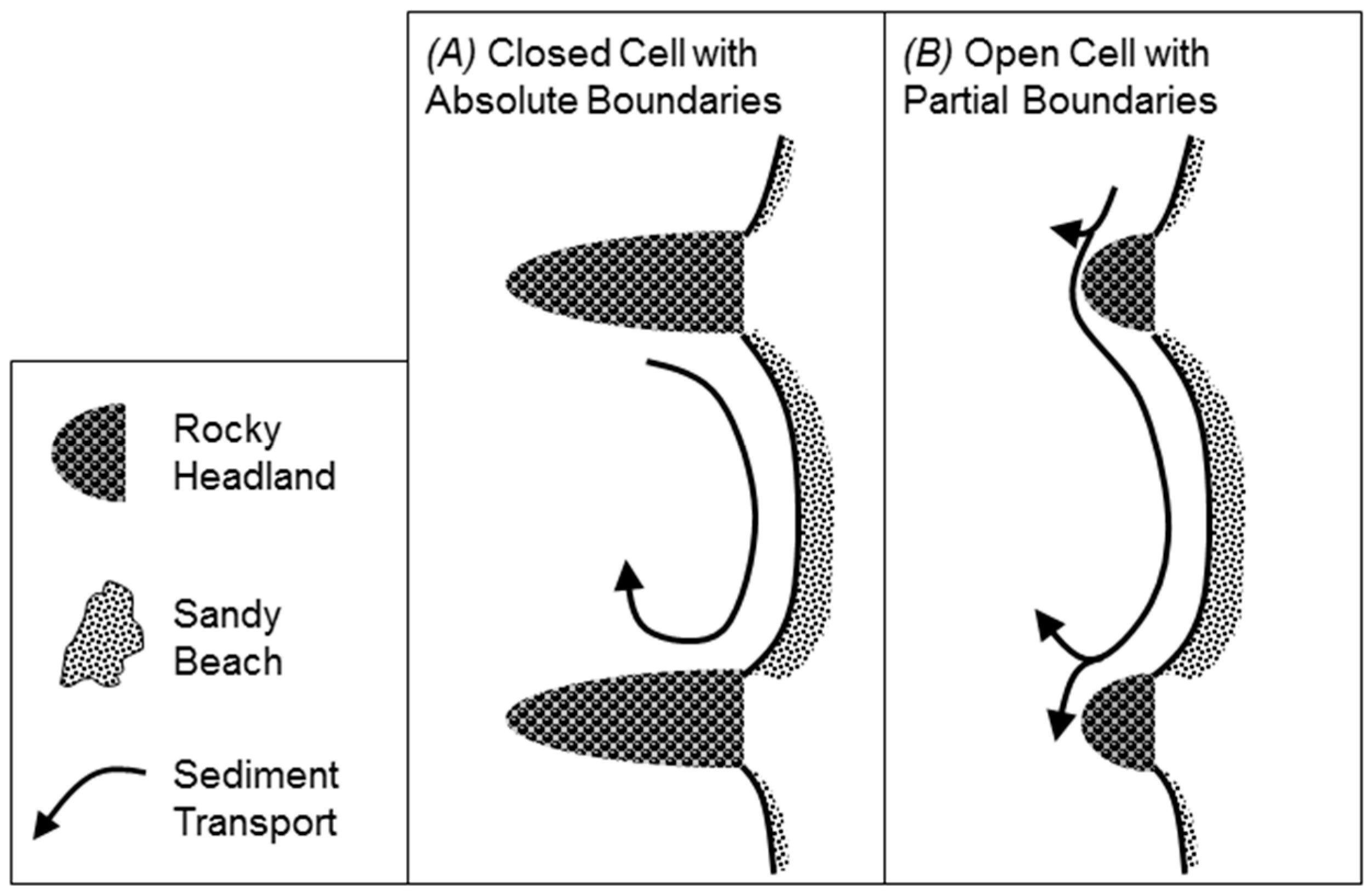
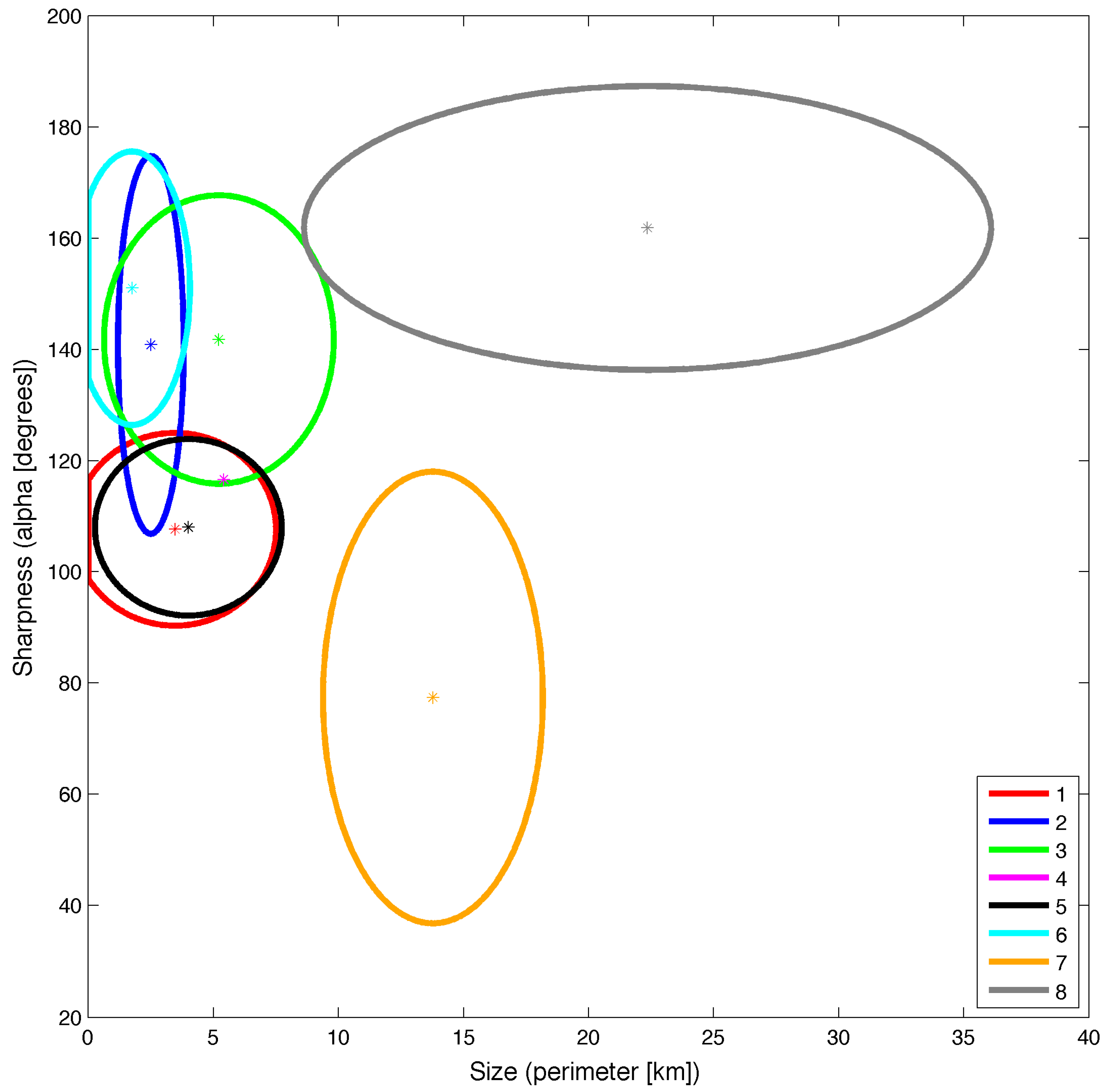
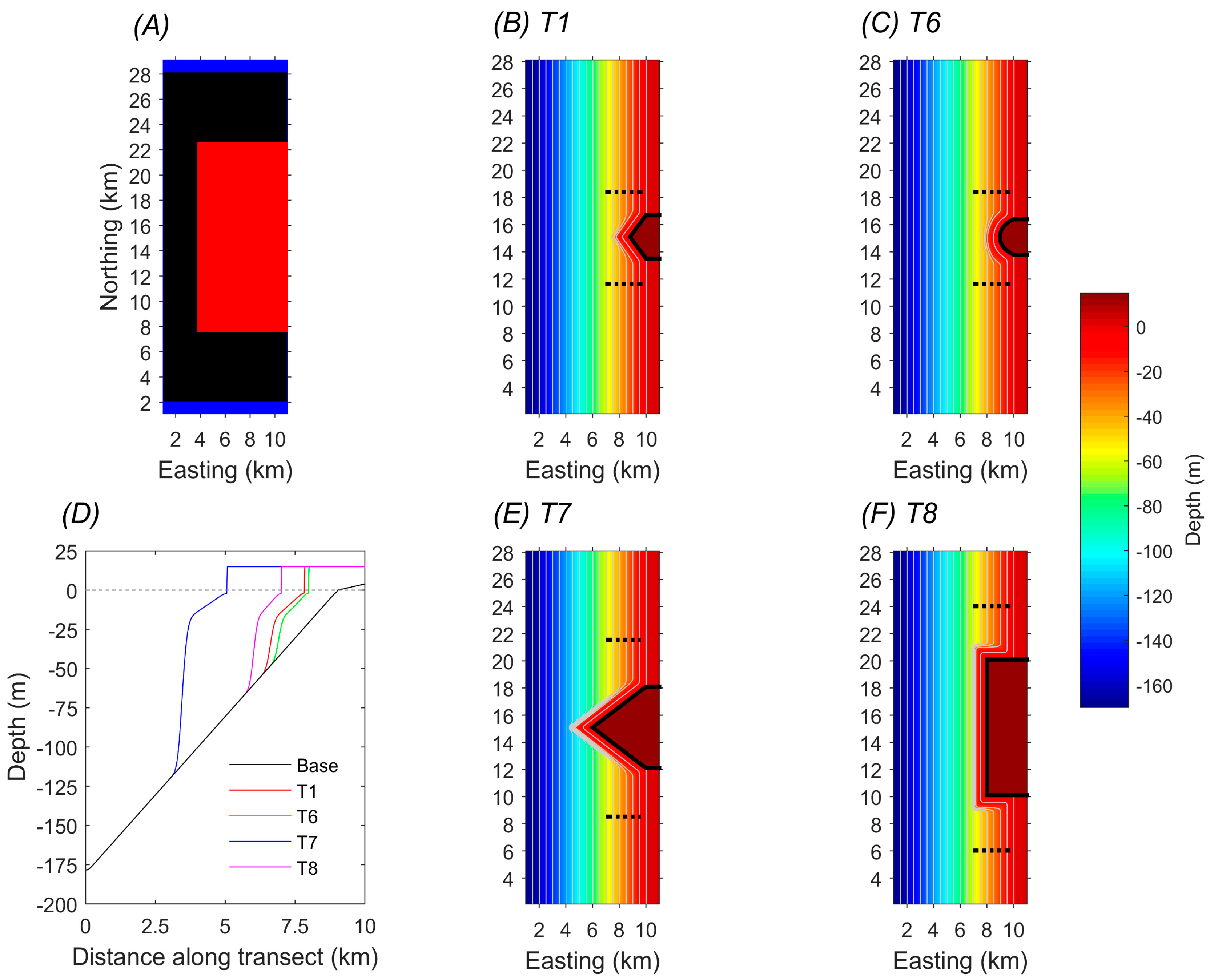
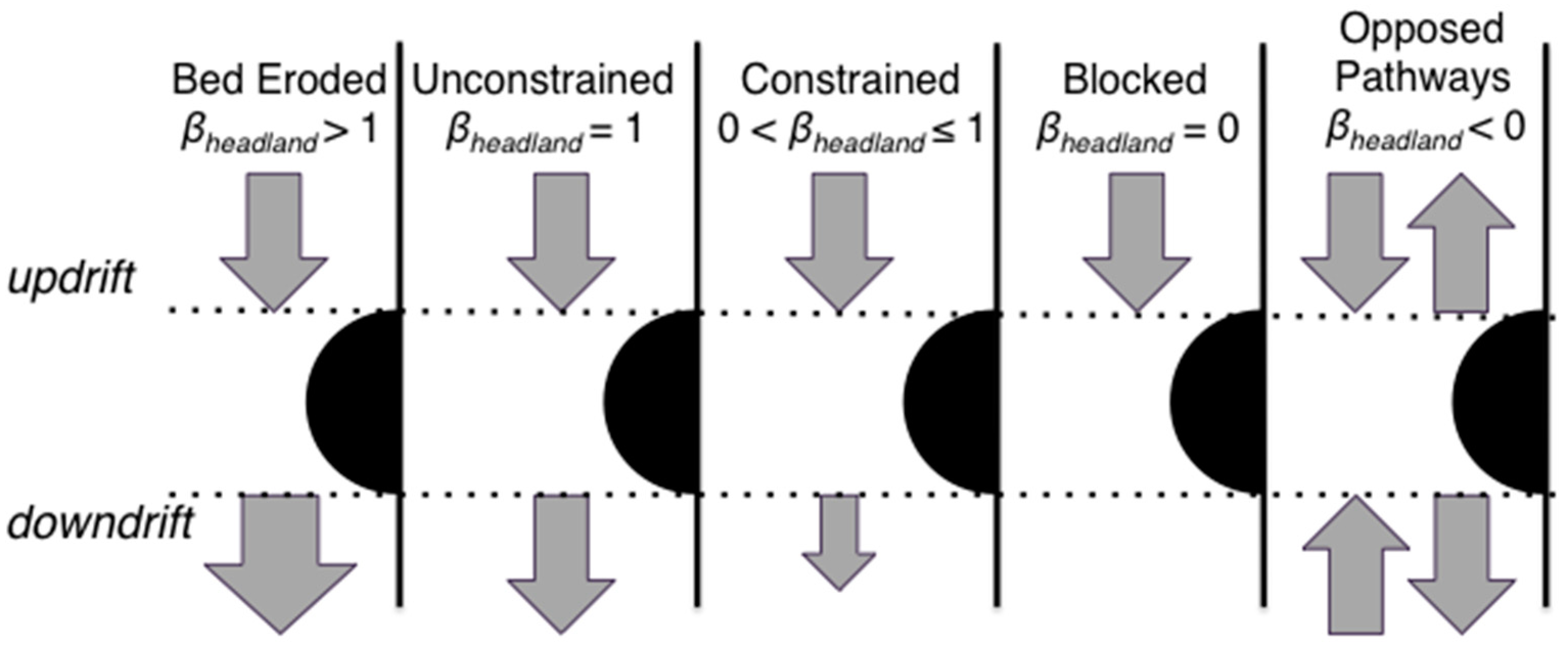
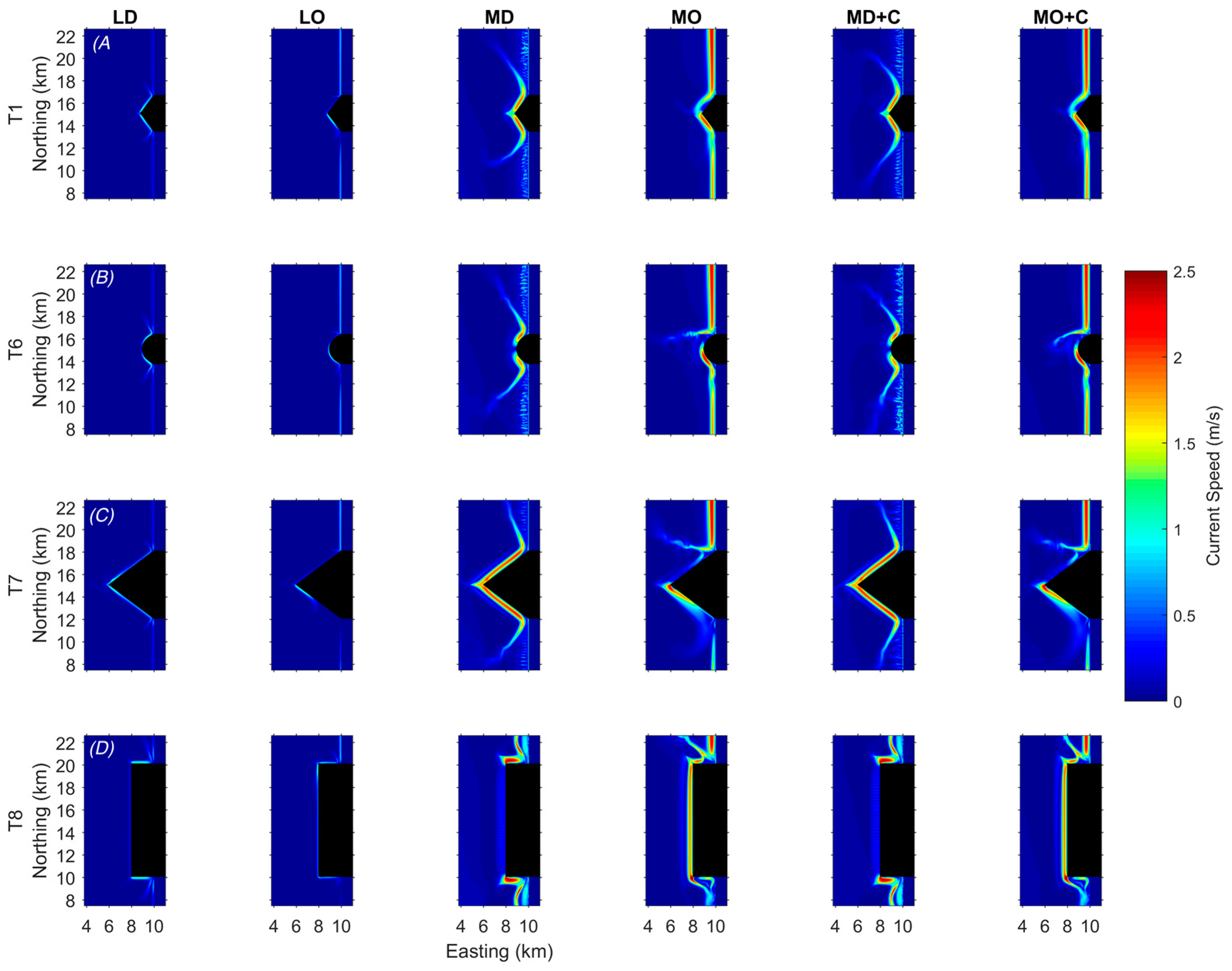

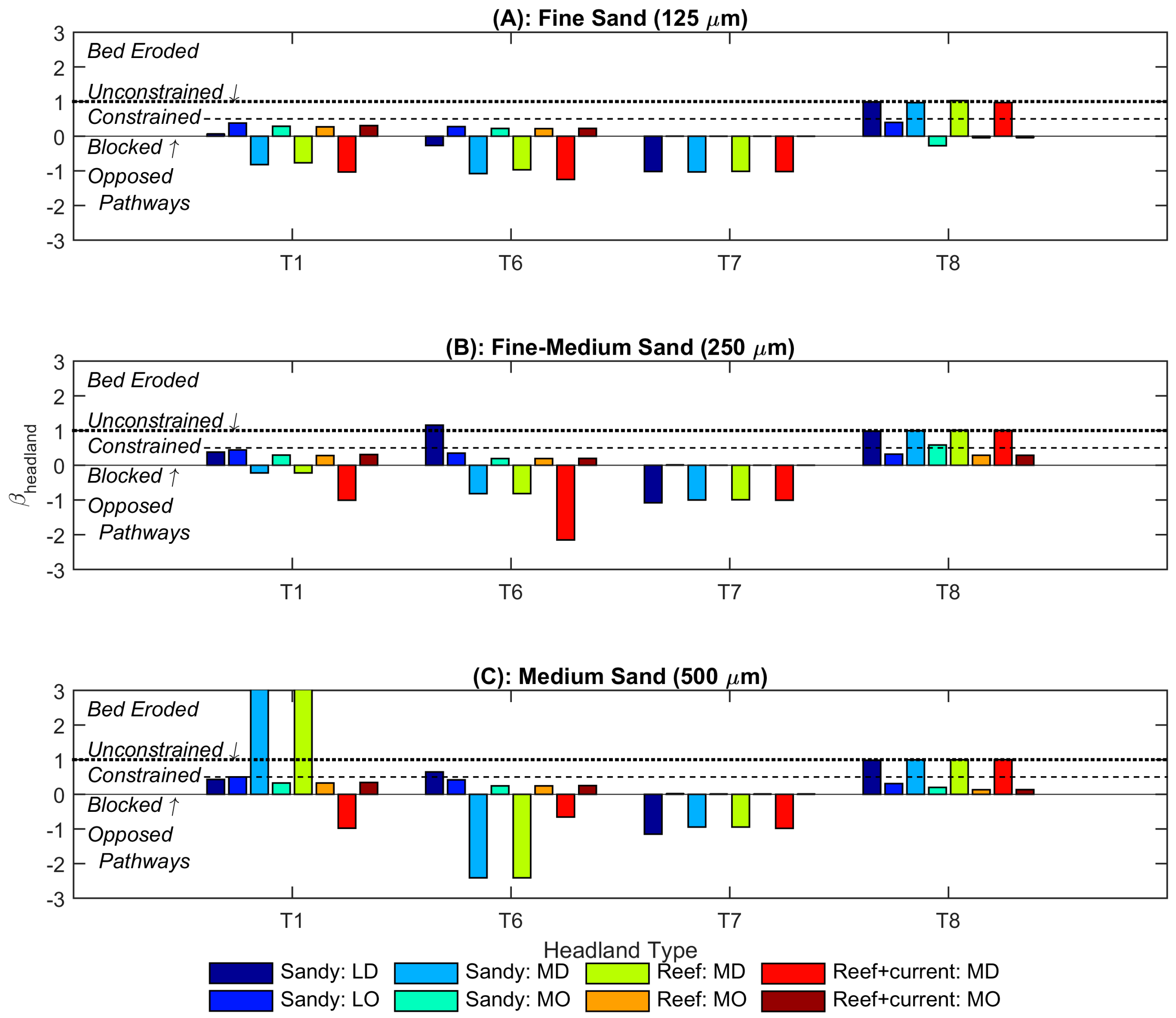
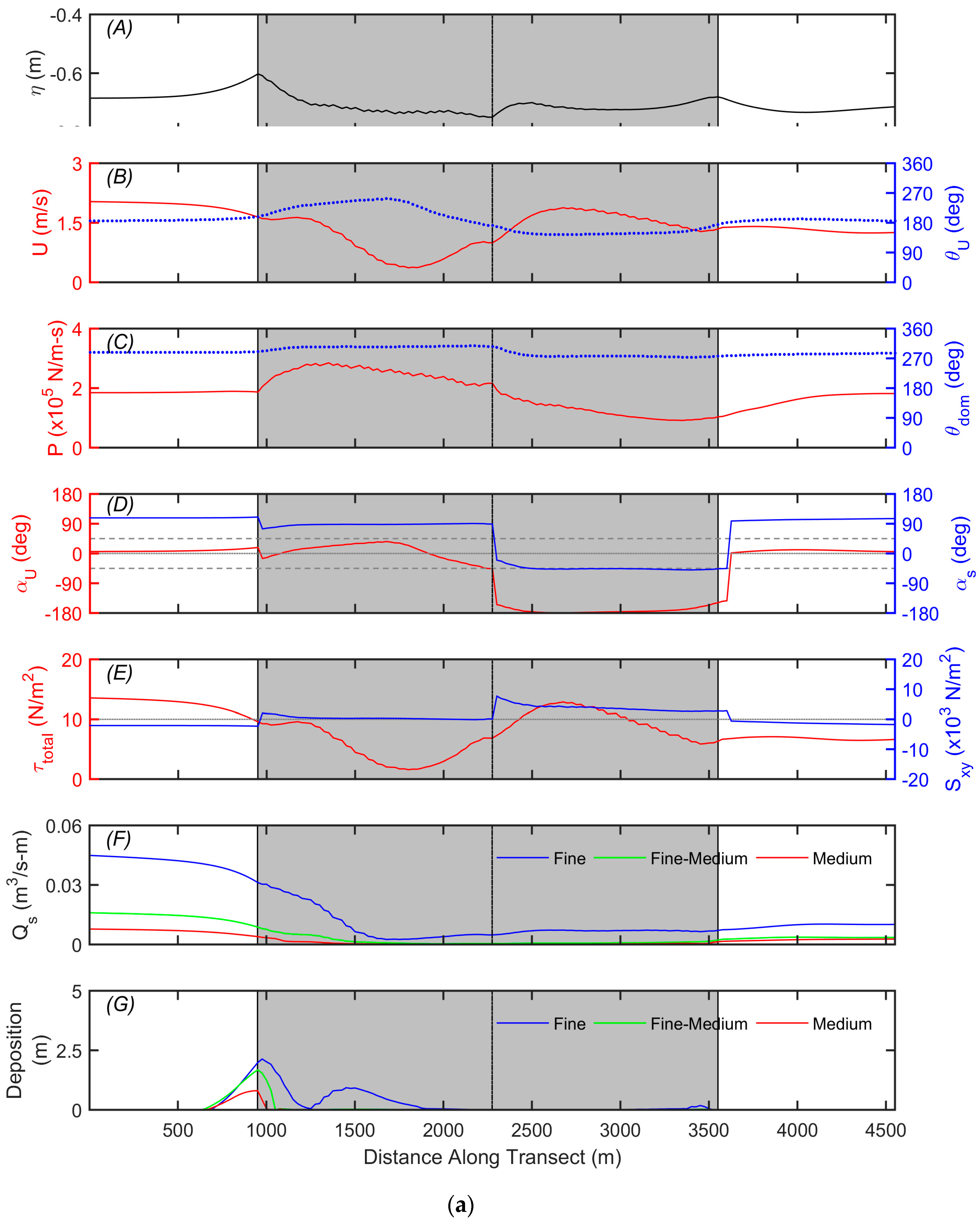
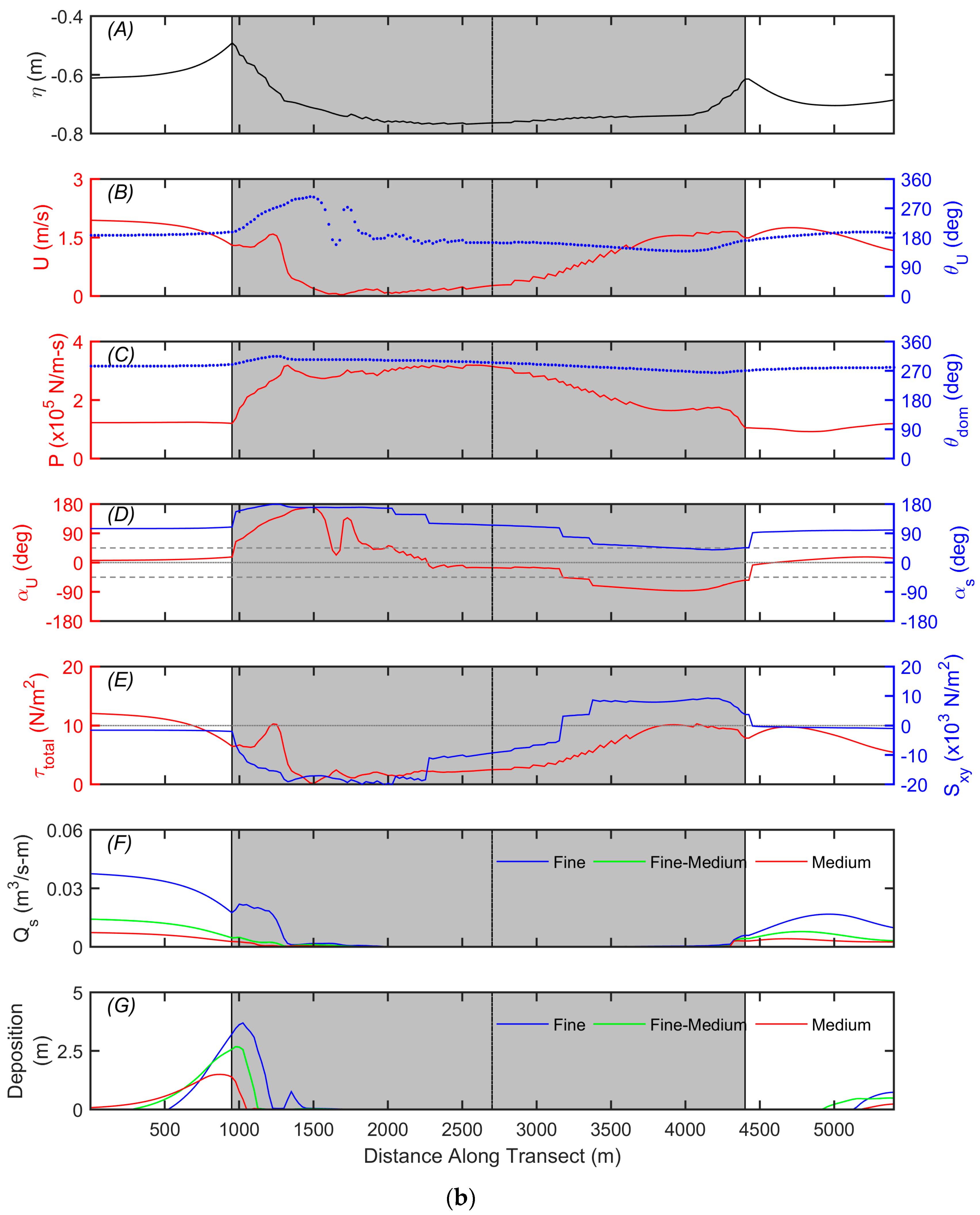
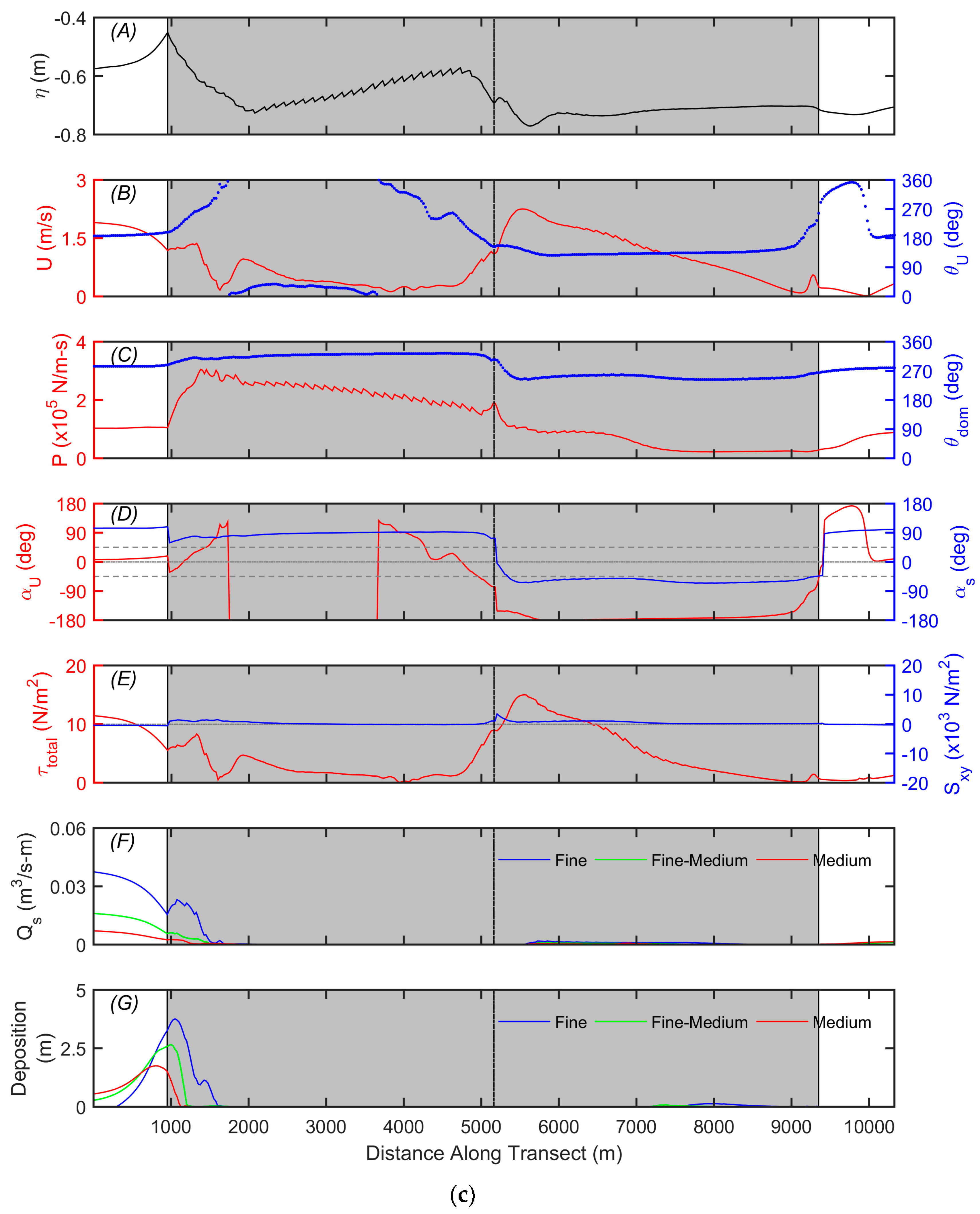
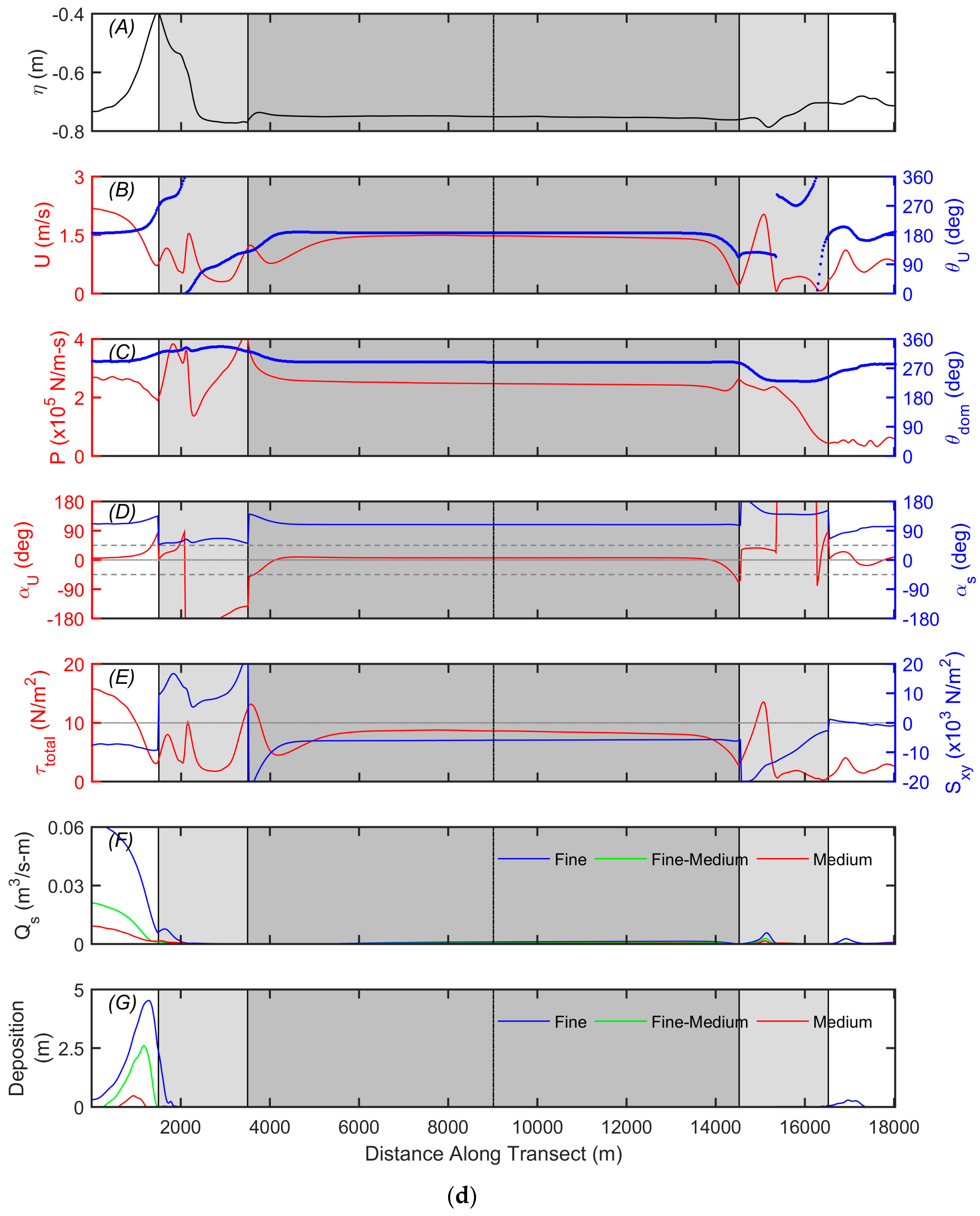
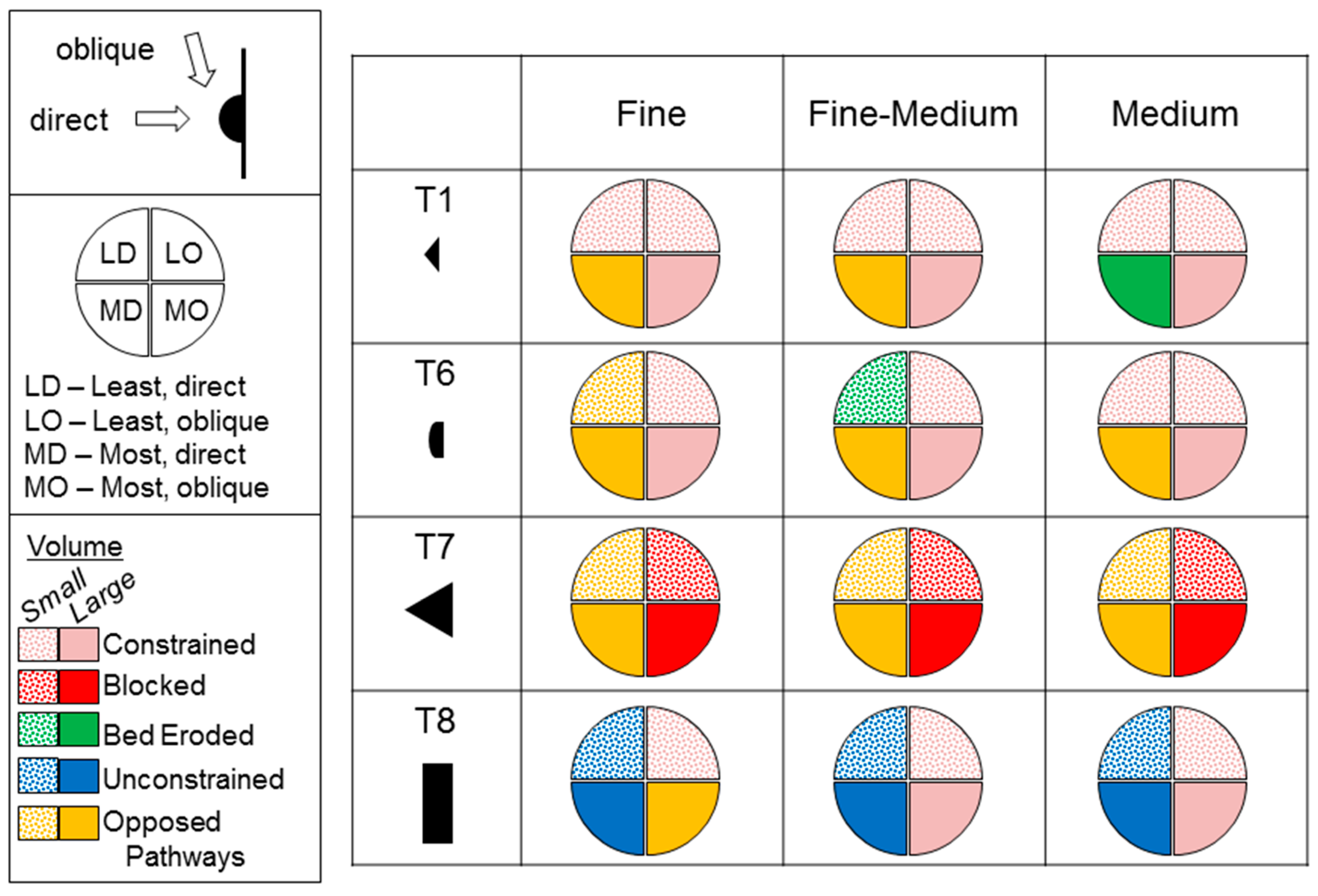
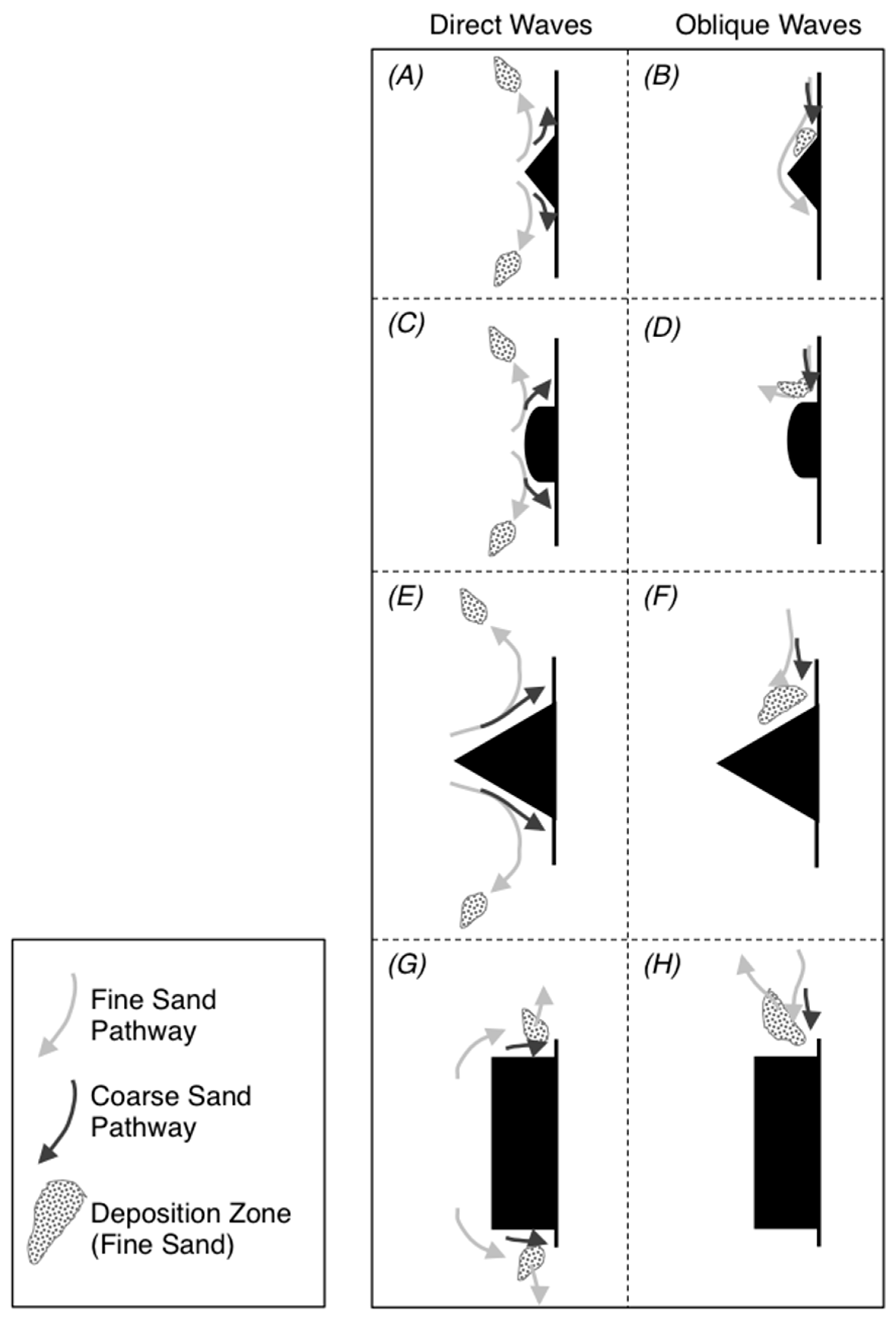
| Factor | Parameter 1 | Spectrum | ||
|---|---|---|---|---|
| Morphology | Headland Size | Small 3 | Medium 3 | Large 3 |
| Headland Shape | Pointed 3 | Curved | Blocky 3 | |
| Headland Symmetry | Upstream Skew | Balanced 3 | Downstream Skew | |
| Aspect Ratio | Length >> Width | Length = Width | Length << Width | |
| Nearshore Shelf Width | Narrow | Medium 3 | Wide | |
| Adjacent Slope | Upstream Deeper | Balanced 3 | Downstream Deeper | |
| Headland-Beach Intersection | Acute | Right | Oblique | |
| Shoreline Rugosity | Smooth 3 | Mixed | Rugged | |
| Offshore of Apex | Ocean 3 | Submerged Reef | Island | |
| Forcing Terms | Wave Height | Small 3 | Medium | Large 3 |
| Wave Period | Short 3 | Medium | Long 3 | |
| Deep Water Wave Angle | Direct (e.g., 270) 3 | Middle (e.g., 315) | Oblique (e.g., 345) 3 | |
| Tidal Range | Micromareal | Mesomareal 3 | Macromareal | |
| Regional Current Speed | None 3 | Slow 3 | Fast | |
| Regional Current Direction | Heading 3 | Across | Following | |
| Wind Speed | None | Slow 3 | Fast | |
| Wind Direction | Onshore | Alongshore 3 | Offshore | |
| Coriolis | Equator | Mid-latitudes 3 | Pole | |
| Sediment | Sediment Type | Muds | Sands 3 | Pebbles |
| Sediment Size (e.g., sand) | Fine 3 | Fine–Medium 3 | Medium 3 | |
| Substrate | Sandy 3 | Mixed | Reef 3 | |
| Sediment Source 2 | Fluvial | Cliff Erosion | Marine 3 | |
| Simulation | Hydrodynamics | Substrate | |||||||||
|---|---|---|---|---|---|---|---|---|---|---|---|
| Description | Tides | Waves | Currents | Sandy | Reef | ||||||
| LD | LO | MD | MO | ||||||||
| Baseline | X | - | - | - | - | - | X | - | |||
| Sandy Bed | X | X | X | X | X | - | X | - | |||
| Reefed Headland | X | - | X | X | X | - | - | X | |||
| Regional Current | X | - | - | X | X | X | - | X | |||
| Headland Class | Description (Size, Apex) | Occurrence of Class in G2015 | Alongshore Length (m) 1 | Cross-shore Distance (m) 1,2 | Apex Angle (deg) |
|---|---|---|---|---|---|
| T1 | Small, medium | 28% | 3200 | 1200 | 107° |
| T6 | Small, broad | 26% | 2600 | 1100 | 151° |
| T7 | Medium, sharp | 6% | 6200 | 2900 | 77° |
| T8 | Large, broad | 6% | 10,000 | 2,000 | 180° |
| Constituent | Amplitude (m) | Phase (deg) |
|---|---|---|
| M2 | 0.50 | 296° |
| S2 | 0.15 | 30° |
| N2 | 0.12 | 28° |
| K1 | 0.36 | 15° |
| O1 | 0.23 | 14° |
| C1 * | 0.41 | 91° |
| Incident Wave Angle | Wave Power Parameters | |
|---|---|---|
| Least | Most | |
| Direct | Hs = 2 m | Hs = 7 m |
| Tp = 10 s | Tp = 16 s | |
| θdom = 270° | θdom = 270° | |
| Oblique | Hs = 2 m | Hs = 7 m |
| Tp = 10 s | Tp = 16 s | |
| θdom = 345° | θdom = 345° | |
| Least Wave Power | |||||
|---|---|---|---|---|---|
| T1 | T6 | T7 | T8 | ||
| Most Wave Power | T1 | - | 2.50 | 0.57 | 0.96 |
| T6 | 1.08 | - | 0.23 | 0.38 | |
| T7 | 1.20 | 1.11 | - | 1.68 | |
| T8 | 0.75 | 0.69 | 0.62 | - | |
| (a) see Equation (4) | Volume Deposited | ||||
|---|---|---|---|---|---|
| Fine Sand | T1 | T6 | T7 | T8 | |
| T1 | - | - | - | - | |
| T6 | 1.13 | - | - | - | |
| T7 | 0.73 | 0.65 | - | - | |
| T8 | 0.49 | 0.44 | 0.68 | - | |
| Fine–Medium Sand | T1 | T6 | T7 | T8 | |
| T1 | - | - | - | - | |
| T6 | 1.31 | - | - | - | |
| T7 | 0.72 | 0.55 | - | - | |
| T8 | 0.56 | 0.43 | 0.78 | - | |
| Medium Sand | T1 | T6 | T7 | T8 | |
| T1 | - | - | - | - | |
| T6 | 1.41 | - | - | - | |
| T7 | 0.69 | 0.49 | - | - | |
| T8 | 0.58 | 0.41 | 0.83 | - | |
| (b) see Equation (5) | Area of Deposition | ||||
|---|---|---|---|---|---|
| Fine Sand | T1 | T6 | T7 | T8 | |
| T1 | - | - | - | - | |
| T6 | 1.44 | - | - | - | |
| T7 | 0.87 | 0.60 | - | - | |
| T8 | 0.58 | 0.40 | 0.66 | ||
| Fine–Medium Sand | T1 | T6 | T7 | T8 | |
| T1 | - | - | - | - | |
| T6 | 1.12 | - | - | - | |
| T7 | 0.57 | 0.51 | - | - | |
| T8 | 0.36 | 0.33 | 0.64 | - | |
| Medium Sand | T1 | T6 | T7 | T8 | |
| T1 | - | - | - | - | |
| T6 | 1.39 | - | - | - | |
| T7 | 0.63 | 0.45 | - | - | |
| T8 | 0.40 | 0.28 | 0.62 | - | |
| Ofactor1 | Ofactor2 | Ofactor3 | ||
|---|---|---|---|---|
| See: | (6) | (7) | (8) | |
| Fine Sand | T1 | 0.06 | 0.02 | 0.90 |
| T6 | 0.01 | 0.01 | 0.94 | |
| T7 | 0.00 | 0.01 | 0.94 | |
| T8 | 0.54 | 0.00 | 0.97 | |
| Fine-Medium Sand | T1 | 0.04 | 0.02 | 0.93 |
| T6 | 0.00 | 0.02 | 0.96 | |
| T7 | 0.00 | 0.01 | 0.98 | |
| T8 | 5.98 | 0.01 | 1.00 | |
| Medium Sand | T1 | 0.03 | 0.03 | 0.94 |
| T6 | 0.00 | 0.03 | 0.96 | |
| T7 | 0.01 | 0.02 | 0.99 | |
| T8 | 2.50 | 0.00 | 0.98 |
| (a) | Grain Size Comparison | |||
|---|---|---|---|---|
| Sfactor1 | Sfactor2 | |||
| See: | (9)a | (9)b | (10)a | (10)b |
| T1 | 1.73 | 0.84 | 3.37 | 0.82 |
| T6 | 2.01 | 0.78 | 2.61 | 0.65 |
| T7 | 1.70 | 0.87 | 2.21 | 0.73 |
| T8 | 1.96 | 0.81 | 2.12 | 0.75 |
| Mean | 1.85 ± 0.16 | 0.82 ± 0.04 | 2.58 ± 0.57 | 0.74 ± 0.07 |
| (b) | Substrate Comparison | ||
|---|---|---|---|
| Sfactor3 | Sfactor4 | ||
| See: | (11) | (12) | |
| Fine Sand | T1 | 1.44 | 1.27 |
| T6 | 1.62 | 1.42 | |
| T7 | 1.25 | 1.32 | |
| T8 | 2.24 | 1.61 | |
| Mean | 1.64 ± 0.43 | 1.41 ± 0.15 | |
| Fine–Medium Sand | T1 | 1.80 | 2.24 |
| T6 | 2.21 | 2.27 | |
| T7 | 1.32 | 1.57 | |
| T8 | 2.78 | 1.84 | |
| Mean | 2.03 ± 0.62 | 1.98 ± 0.34 | |
| Medium Sand | T1 | 2.02 | 2.56 |
| T6 | 2.51 | 3.04 | |
| T7 | 1.53 | 1.90 | |
| T8 | 2.86 | 1.88 | |
| Mean | 2.23 ± 0.58 | 2.34 ± 0.56 | |
| Transect length (m) | Δη (m) | U (m/s) | θU (deg) | P (×105 N/m-s) | θdom (deg) | αU (deg) | αs (deg) | ||||||||
|---|---|---|---|---|---|---|---|---|---|---|---|---|---|---|---|
| N * | S * | N | S | N | S | N | S | N | S | N | S | N | S | ||
| T1 | 4500 | 0.15 | 0.07 | 0.4–2.0 | 1.0–1.8 | 186-–250 | 144–190 | 1.9–2.8 | 0.9–1.8 | 287–307 | 276–306 | −45–36 | −174–10 | 78–108 | −49–99 |
| T6 | 5500 | 0.27 | 0.15 | <0.1–2.0 | 0.3–1.8 | 186–305 | 138–197 | 1.2–3.1 | 0.9–3.1 | 285–314 | 264–292 | −15–170 | −89–17 | 104–180 | 39–115 |
| T7 | 10,000 | 0.27 | 0.10 | 0.1–2.0 | <0.1–2.3 | 0–360 | 126–353 | 1.0–3.0 | 0.2–1.9 | 284–324 | 244–305 | 7–123/180 | −180–173 | 76–104 | −62–95 |
| T8 | 18,000 | 0.36 | 0.11 | 0.3–2.1 | <0.1–2.0 | 0–360 | 0–360 | 1.3–4.0 | 0.3–2.6 | 291–336 | 230–288 | −180–83 | −67–180 | 47–135 | 65–180 |
| τtotal (N/m2) | Sxy (×103 N/m2) | Qs max (fine) (m3/s-m) | Qs max (f-m) (m3/s-m) | Qs max (med) (m3/s-m) | Deposition max (fine) (m) | Deposition max (f-m) (m) | Deposition max (med) (m) | |||||||||
|---|---|---|---|---|---|---|---|---|---|---|---|---|---|---|---|---|
| N | S | N | S | N | S | N | S | N | S | N | S | N | S | N | S | |
| T1 | 1.5–13.5 | 5.8–12.9 | −2–1.9 | −1.5–7 | 0.04 | 0.01 | 0.02 | <0.01 | 0.01 | <0.01 | 2.1 | 0.2 | 1.7 | 0 | 0.8 | 0 |
| T6 | 0.2–12 | 2.4–9.7 | −1.6–−2.0 | −9.1–9.1 | 0.04 | 0.02 | 0.01 | 0.01 | <0.01 | <0.01 | 3.7 | 0.7 | 2.7 | 0.4 | 1.5 | 0.2 |
| T7 | 0.2–11.4 | 0.2–15 | −0.4–1.1 | 0–3.0 | 0.04 | <0.01 | 0.01 | <0.01 | <0.01 | <0.01 | 3.7 | 0.1 | 2.6 | 0 | 1.7 | 0 |
| T8 | 1.7–15 | 0.6–12.4 | −20–20 | −20–1.2 | 0.06 | 0 | 0.02 | 0 | <0.01 | <0.01 | 4.5 | 0.3 | 2.6 | 0 | 0.5 | 0 |
| Headland Class | Headland Shoreline Angle (from North) | Direct Wave (270°) | Oblique Wave (345°) | ||
|---|---|---|---|---|---|
| αb | sin(2αb) * | αb | sin(2αb) * | ||
| T1 | 217° | 53° | 0.96 | 128° | −0.97 |
| T6 | 195° | 75° | 0.50 | 150° | −0.87 |
| T7 | 231° | 39° | 0.98 | 114° | −0.74 |
| T8 | 90° (north) | 180° | 0.00 | 255° | 0.50 |
| 180° (west) | 90° | 0.00 | 165° | −0.50 | |
© 2019 by the authors. Licensee MDPI, Basel, Switzerland. This article is an open access article distributed under the terms and conditions of the Creative Commons Attribution (CC BY) license (http://creativecommons.org/licenses/by/4.0/).
Share and Cite
George, D.A.; Largier, J.L.; Pasternack, G.B.; Barnard, P.L.; Storlazzi, C.D.; Erikson, L.H. Modeling Sediment Bypassing around Idealized Rocky Headlands. J. Mar. Sci. Eng. 2019, 7, 40. https://doi.org/10.3390/jmse7020040
George DA, Largier JL, Pasternack GB, Barnard PL, Storlazzi CD, Erikson LH. Modeling Sediment Bypassing around Idealized Rocky Headlands. Journal of Marine Science and Engineering. 2019; 7(2):40. https://doi.org/10.3390/jmse7020040
Chicago/Turabian StyleGeorge, Douglas A., John L. Largier, Gregory Brian Pasternack, Patrick L. Barnard, Curt D. Storlazzi, and Li H. Erikson. 2019. "Modeling Sediment Bypassing around Idealized Rocky Headlands" Journal of Marine Science and Engineering 7, no. 2: 40. https://doi.org/10.3390/jmse7020040





